Missing Voices and Misogyny in Shakespeare Theatre Company’s All-Male Shrew
Perhaps the best place to preface a critique of Shakespeare Theatre Company’s all-male Taming of the Shrew is the end: Katherina (Kate) delivers her final speech with unflinching honesty, bemoaning that women “seek for rule, supremacy, and sway/ Whey they are bound to serve, love, and obey.” She implores Bianca and the Widow to join her, creating a silent, encapsulating snapshot: three women prostrate before their husbands, hands extended to be crushed beneath their companions’ feet. Regardless of the corseted actors’ gender identities, Shakespeare Theatre Company leaves audiences with a searing image of female submission to men—about as traditional an interpretation of Shakespeare’s play as one can find.
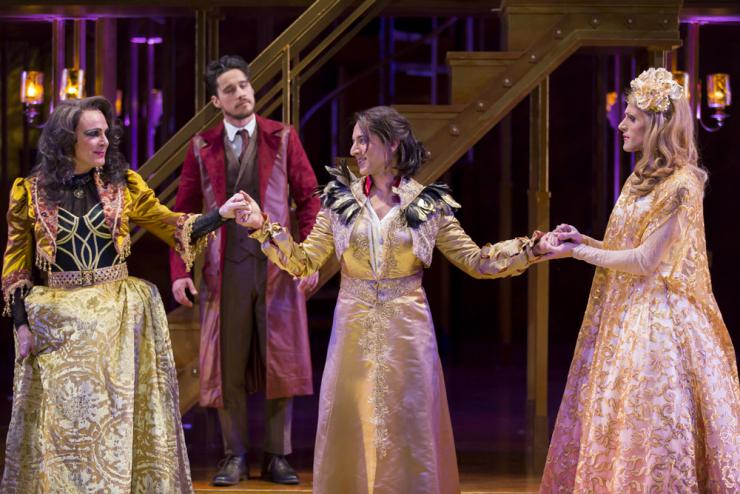
The unintentional misogyny in the production perhaps came from the fact that women appear to have been excluded from the artistic process (at first glance, other than an assistant stage manager, costume designer and voice/text coach, this was an utterly male production team). The male-to-female ratio of Shakespearean roles—16 to 3—is hardly a new statistic. Given this constant disadvantage, I believe a director needs an infallible concept to justify removing women from the payroll—and for me, director Ed Sylvanus Iskandar’s fell short.
The conceit behind this regendering is promising: Iskandar attests that removing the audience’s expectations allows for an honest examination of marriage and identity. In his director’s note, he describes the production as a “proxy for his own adolescence,” an examination of otherness that transcends social constructs to reveal how people of all genders and sexualities construct protective, socially acceptable outer shells. The note also includes the following explanation:
It seems monstrous to ask a woman to perform [the final monologue] in today’s world, but it’s a bitter irony that I’m not using women in order to mount a show about a woman’s point of view…. After all, misogyny is not the problem of the woman, but that of the male world that perpetrates it.
As the production’s closing image exemplifies, men in dresses does not automatically transcend gender normativity—in this case, it accomplishes precisely the opposite. The true “bitter irony” of this reconceived Shrew is that it does not subvert the play’s troubling history—400 years of Kates being gaslit and starved by their Petruchios—but perpetuates harmful gender stereotypes and demonstrates how narrowly the artistic team interpreted the female perspective.
The true ‘bitter irony’ of this reconceived Shrew is that it does not subvert the play’s troubling history—400 years of Kates being gaslit and starved by their Petruchios—but perpetuates harmful gender stereotypes and demonstrates how narrowly the artistic team interpreted the female perspective.
The world of this Padua is a glitter-laden, promising start: enormous paper lanterns frame the stage, the centerpiece of which is a golden, revolving pedestal with an array of ladders and balconies. It is a strikingly beautiful world, and the costumes indicate a sense of upper class snobbery that astutely frames the ridiculousness of the characters’ rigid hierarchical world. Padua literally tumbles into the immersive lobby, embodying the immensity and scope of its social structure.
But the most notable of the design choices is as gendered as a design can be: nearly all of the men don enormous codpieces over their pants, regardless of the time period from which their costumes are inspired. Adding to this barrage of male virility, nearly every line is delivered as a sexual innuendo. Despite some attempts at developing the play’s many secondary characters, the men are largely used for broad comic relief, going so far as to make one suitor’s fatal heart attack (an explanation for one character’s disappearance midway through the play) into a minute-long gag. These choices have the potential to ironically display the insecurities instilled by a hyper masculine world; they are ultimately played for slapstick laughs rather than subversive humor, and paint a sweeping, surface-level picture of men as lewd and self-absorbed.
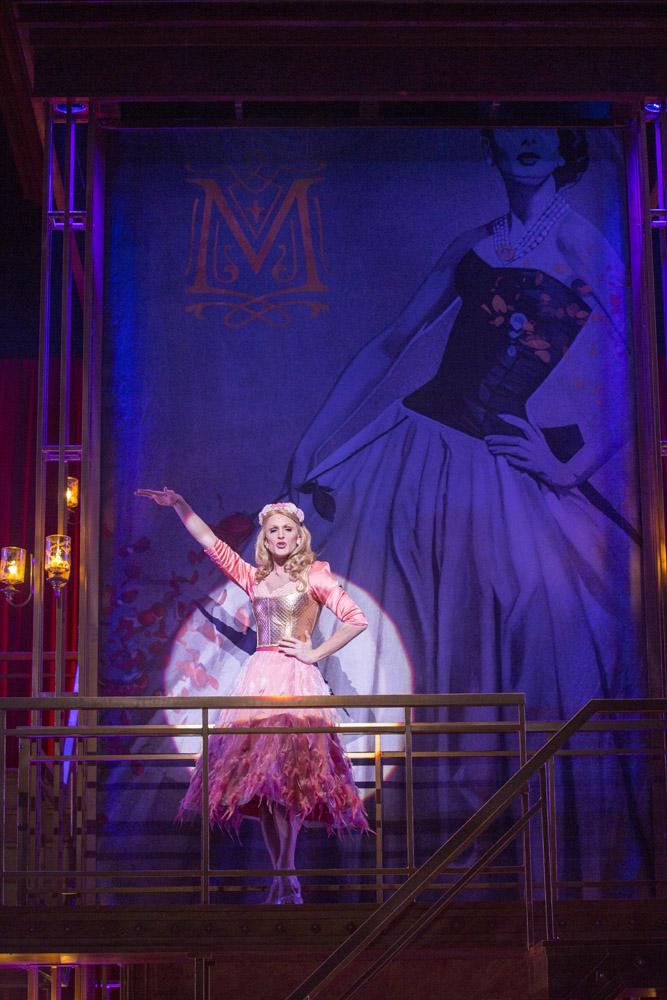
The female characters are equally unimaginatively rendered. Bianca is a virtual Barbie doll, complete with immaculate blonde hair, a modest but waist-cinching pink dress, dangerously high heels, and a Disney princess-esque habit of weightlessly drifting about the stage. Her undesirable sister is corseted, styling a beret and, occasionally, even pants—a beatnik black sheep ensemble, implying a nonconforming inner strength that unfortunately never realizes itself onstage.
This regendered Taming could be a unique opportunity to give voice to Kate’s otherwise silenced inner world, particularly via musical interludes by singer-songwriter Duncan Sheik of Spring Awakening fame. These buoyant pop songs offer plenty of insight into characters’ psyches, but largely introduce subplots about secondary characters rather than expand on the play’s silenced women. Highlighting these other stories—from Tranio’s secret love for Lucentio to Bianca’s desire for the servant Biondello—is commendable. The songs excavate how the nuanced ramifications of a strictly gendered world make everyone “Play Your Part,” as one of Bianca’s songs tells us.

The shrew herself, however, is given the musical spotlight only once, in one of the production’s less subtle duets, “You’re in Magazines.” As if the original text didn’t offer enough opportunities to excavate the damaging impacts of a patriarchal society, here Iskandar heaps on another layer of gendered social complexities: high fashion. Two of the set centerpiece’s four sides are emblazoned with enormous images, each stamped with the Minola fashion logo: one features a lithe model striking a pose (head cut notably off), in front of whom Bianca often appears; the other, the same model fractured by mosaics, not-so-subtly representing Kate. Baptista exploits his younger daughter’s beauty by making her the face of his Vogue Padua, and as the duet contends, this life of glamour is not as it seems:
Now everyone can gaze upon your body
It’s good for you I guess you have no shame
I never knew that I how I acted would make you seek revenge
And now I know, and you’re in magazines
But was it really you?
Bianca and Kate’s conflict revolves around jealousy alone. Even their fight scene comes from a place of bruised pride rather than anger, failing to illuminate the extent of Kate’s internal rage; instead, she half-heartedly ties Bianca up with a measuring tape (which becomes a bondage-style addition to Bianca’s photo shoot) then proceeds to meekly pinch and poke her unintimidated sister. This non-violent Kate resists her oppressors by hissing and rolling her eyes—even her famous introduction to Petruccio is devoid of violence, instead staged as love at first sight.
Petruchio is introduced sans codpiece, an immediate indication of his status as an outsider, a less-than-socially-acceptable guest at the Minola estate. His first scene is rife with breaches in etiquette, from picking his feet to play-wrestling with his servant; this presents a potentially fascinating Kate-Petruchio narrative, in which they are genuinely attracted to each other’s experience as others. This potential is dashed, however, as early as their wedding scene, when Petruchio appears as a macho shrew-tamer, complete with codpiece and animal skin attire. He never returns to his early compassion or depth, instead taking joy in his psychological taming methods and bonding with his clan of shirtless servants.
Petruchio’s relationship to Kate is that of a savior. Early in his taming, after Kate succumbs to the psychological torture of sleep deprivation, he releases her from the restraints of her corset so that she can finally take a breath of relief. Kate’s submissive final monologue is similarly staged; Petruchio allows her to rise, removing her outer layer to reveal a feathered tunic—a phoenix, rising from the ashes.
The particularly troubling aspect of these moments is that Kate’s enlightenment is not an active choice. One of few elements that consistently resonates in Shakespeare’s original play is how its female characters actively resist the patriarchy—Bianca through pretending to conform while hiding a spiteful, biting spirit, and Kate by literally fighting against her male oppressors. Although neither story ends as modern audiences may wish, these battles make the play engaging and alive.
Maulik Pancholy’s comparatively tame Kate has been one of the only consistently lauded elements of the production, with critics citing her as “sober,” “rueful,” and “frighteningly vulnerable”—and this Kate is certainly rare; she is tired, hopeless, and ready to surrender as soon as her male savior swoops in to compliment her appearance. But it is no coincidence that Kates have, for decades, been violent, cruel, and unlikable; they have been, since the Restoration at least, portrayed by mostly female actors—women who can tap into the frustrations and anger of Shakespeare’s battered heroine in a way that male actors simply cannot. While unconventional, Pancholy’s Kate has no room to develop, which strips her story of any momentum.
Like many well-intentioned stories in which a member of a non-oppressed group tells a story of the oppressed, the results are at best oversimplified, at worst hurtful.
As for the all-male conceit, the production evokes no sense of irony or satire in its stereotypical genderings. Warped or even caricatured interpretations of the characters may have struck provocative questions about the superficiality of gender constructs—but as is, Kate and Bianca’s attempts at nuance are counterintuitive to the production’s motivation for removing the taboo male-on-female abuse, offering instead a very traditional image of women acquiescing to their husbands.
The glitz, glamor, even traditionalism of this production could have been a powerful tool for holding the audience implicit in this play’s suffocating social structure (they are literally invited to Kate’s wedding during intermission), but the production bedazzles audiences in precisely the wrong way; instead of illuminating viewers to how misogyny subtly thrives in even the most seemingly pristine worlds, the overblown design and slapstick antics blind them from this darker truth.
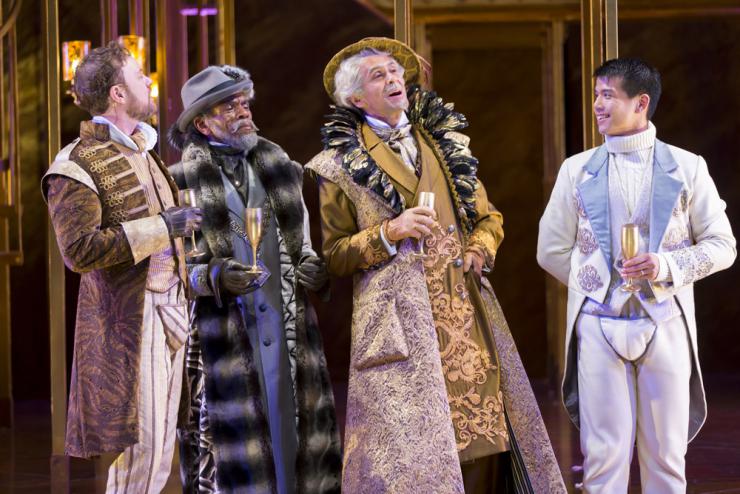
With every musical interlude and othered male character, this Shrew attempts to examine how misogyny warps everyone’s identity, regardless of gender—but like many well-intentioned stories in which a member of a non-oppressed group tells a story of the oppressed, the results are at best oversimplified, at worst hurtful. It is a production that speaks to the ever-critical need for a range of identities and voices in a room, however well-intentioned any exclusivity may be.



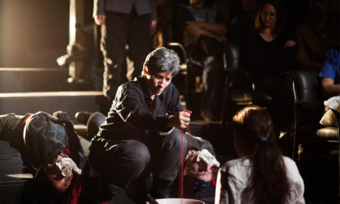
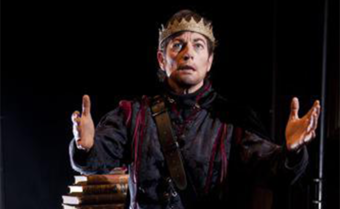

Comments
The article is just the start of the conversation—we want to know what you think about this subject, too! HowlRound is a space for knowledge-sharing, and we welcome spirited, thoughtful, and on-topic dialogue. Find our full comments policy here
I read Clearwood's intelligent and articulate article with great interest, but ultimately found it frustrating. Firstly, I feel as if there is an unresolved tension: there are several instances when Clearwood describes a particular piece of the concept, saying something along the lines of, "That is a promising idea that could have worked, but doesn't here"; but this seems at odds with her conclusion that, ultimately, the project was fundamentally flawed and could never have succeeded, existing, as it does, in the context of "missing voices." More troubling, I found the article to be a repudiation of drag culture, and, therefore, comparably oppressive to the point of view it critiques. I didn't see the production, and can't therefore comment on the extent to which, if any, a drag aesthetic was part of its mix. However, Clearwood goes much broader than the production only with her categorical "women...can tap into the frustrations and anger of Shakespeare’s battered heroine in a way that male actors simply cannot." I can't disagree more. This speaks against scores of performances that I have experienced. Drag is empowering, cathartic, historically important to our movement for inclusion, and Clearwood, intentionally or not, argues here for its marginalization or its exclusion. If anyone feels read-out of the culture by STC's all-male Shrew, I feel read-out by this response to it.
Clearwood, if she is critiquing drag culture (which I'm not sure she is), would not be the first to do it. Much scholarship has been done on the ways that men dressing as women tends to reinforce gender stereotypes rather than challenge them. This line of thought is even referenced in Angels in America. I agree with Clearwood's fundamental premise that simply presenting gender does not constitute a critique of it. When men play women in gender normative dress and makeup while acting stereotypically feminine, they are simply presenting the idea that being a woman requires being feminine, not investigating it.
I wasn't arguing that drag necessarily challenges gender stereotypes. (And I don't, by the way, think that that's the only goal of performance.) I was arguing that a gay guy who has lived a life full of bullying, beatings, family rejection, and fear of professional retribution, one who currently feels one election or Supreme Court justice away from losing the legal recognition of his marriage and his family, that that artist just might could, I think, tap into enough "frustration and anger" to empathically imagine a different, though in some respects similar, experience of oppression. I disagreed with Clearwood's assertion that he "simply cannot." (I also would object to someone who thought that the gay experience couldn't be artistically imagined by a straight woman.) Clearwood's conclusion struck me as an argument that not only inhibits the range of possible or allowed gender experimentation regarding classical theatre (and I'm a big proponent of those sorts of experiments, going in both directions) but also that questions the enterprise of art in general, the vast majority of which involves imagining experience different to one's own. Of course, there are limits drawn for reasons of cultural sensitivity. No Euro-American actor is likely to play Othello or Troy in Fences without resistance. Blackface now wold be almost impossible to imagine --almost, I say, because, interestingly, it was employed somewhat recently by Kate Valk for Wooster Group's Emperor Jones. Though there was protest, there likely would have been more had a straight white male done blackface. That there wasn't more outrage, I would suggest, is because there is an expectation of some sort of community among, or heightened sensitivity between, (Clearwood's term) oppressed groups. Relatedly, the genesis of drag comes not only from many gay men having what are perceived to be female mannerisms, but also because early/mid 20th century (mostly) closeted gay men felt kinship to women, whether characters who are ostracized from society (like Camille, famously played in drag by Charles Ludlam) or whether cultural icons like Callas and Garland, whose passions were outsized and allowed cathartic expression for all who felt marginalized and outside not only privilege, but also basic acceptance. And I do think that queerness challenges gender stereotypes. When gay men associate not only with the mannerisms and dress, but also with attributes, of women -- emotional accessibility vs reserve, gentleness vs aggression, vulnerability vs inflexibility, etc, etc -- that challenges perceptions of gender roles. Most drag queens (I respectfully suggest that hld6 needs to branch out into drag culture beyond only the pageant girls) juxtapose images of glamour against pater that is sexually explicit, tough-minded, challenging...in a word, fierce! -- not at all any notion of docile, stereotypical female capitulation. So, I bridled at hld6's generalization "they are simply presenting the idea that being a woman requires being feminine, not investigating it." Perhaps issues of gender parity are so charged that Kate in Shrew should be elevated to the level that Othello now occupies, where it just wouldn't be sustainable to essay the role of Kate if you aren't a woman. That would distinguish it from, say, Shylock -- we just had a famous gentile actor come to town to play that role -- or characters in Angels in America -- not long ago, Forum did a production in which all of the gay white men were played by straight white men, and both of the directors were straight white men. I don't recall anyone, including Clearwood, objecting that voices were missing at that table. And the fact that she may have been unaware of it is no excuse. (Grin.) Anyway, I wish we could have that conversation about Kate without aspersion on gay or drag culture, which is the point behind my posts. I do want to say that (production unseen) I felt that Clearwood's case against the well-intentioned Shrew was convincing, until the generalization to which I objected. Meanwhile, hld6's defense of Clearwood is more overtly dismissive. If the reference to vague scholarship or Kushner without context is meant to drop the mic, I must protest and say that I find the assessment of drag to be counter-experiential and seeming to demonstrate a zero-sum attitude toward empowerment, as if women can only gain agency at the expense of gay and drag culture, the latter of which (s)he seems intent on diminishing. I am an acquaintance of Clearwood and meant my first post to be more playful than, to be fair, it seemed to me upon re-reading. I was very sympathetic to her argument until it veered into the categorical. She also speaks about sensitivity in her conclusion when she writes: "...the results are at best oversimplified, at worst hurtful." I hope anyone who expresses such an expectation -- hoping that performance won't be hurtful toward an exposed group --would be similarly sensitive toward others. I want to read an article such as this and feel, "I'm with her!" without feeling an explicit call to limit the boundaries of artistic exploration, or an implicit call to compromise my own pride in our identity and culture.
At first, my perspective of an all male Shrew cast was that of, indifference. I mean, why not? As I continued reading however, I began to realize that without ever seeing the play, I found myself lost and without the ability to understand the comparisons of past Shrew casts. So, I just had to take Maegan's word for it.
This is what I've come to understand from reading this article: When you cast people that are not seen/recognized as oppressed within that story; whether its because of gender or race or culture or religion or a combination of traits; you risk the audience taking offense and greatly diminish your chances of sending the message you want to send. I don't know how to fix this challenge storytellers have but I hope someday, I will figure it out.
"With every musical interlude and othered male character, this Shrew attempts to examine how misogyny warps everyone’s identity, regardless of gender—but like many well-intentioned stories in which a member of a non-oppressed group tells a story of the oppressed, the results are at best oversimplified, at worst hurtful. It is a production that speaks to the ever-critical need for a range of identities and voices in a room, however well-intentioned any exclusivity may be." (Maegan Clearwood) This conclusion is what really made me understand the point of view the journalist was coming from.
This essay has empowered me to admit a secret I've held for thirty years: My favorite version of "The Taming of the Shrew" (funnier and much better ending!) is "Atomic Shakespeare" (an episode of "Moonlighting")! If you've never seen it, check it out! http://www.imdb.com/title/t...